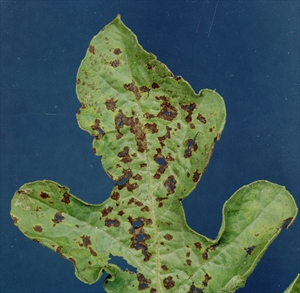Cucurbit anthracnose
Pacific Pests, Pathogens and Weeds - Online edition
Pacific Pests, Pathogens & Weeds
Cucurbit anthracnose (200)
Colletotrichum orbiculare; sometime known as Colletotrichum lagenarium. Three races are known.
Asia, Africa, North, South and Central America, the Caribbean, Oceania. It is recorded on cucurbits from Australia, American Samoa, Federated States of Micronesia, Fiji, Marshall Islands, New Caledonia, New Zealand, Palau, Papua New Guinea, Samoa, and Tonga.
Common on cucurbits, i.e., members of the cucumber family, especially, cucumber, melon and watermelon.
All aboveground parts of cucumber, melon and watermelon are susceptible to infection. However, symptoms vary depending on the host. On watermelon leaves, the spots are irregular, angular, and turn dark brown or black (Photo 1); on cucumber and melon, the spots are small, brown with haloes, later enlarging as round, reddish-brown spots. The centers of the spots fall out, giving the leaf a 'shot-hole' appearance (Photo 2). On the stems, the spots may cause the plants to wilt, especially melons.
On the fruit, round, pale brown, sunken spots (up to 6 mm deep) with raised margins, up to 30 mm diameter, often more common on the lower half on melon (Photo 3). The fruit become infected as they start to mature. The lesions are water-soaked, greyish, lacking a clear margin at first, and then turn dark green to brown. Pink to orange spore masses occur on the spots during wet weather. The spots on cucumber are smaller, sunken and clearly show the masses of spores (4-6).
Other rot-causing fungi and bacteria enter the spots and completely destroy the fruit.
Spread over relatively short distances occurs as spores in wind-blown rain. Spread over longer distances occurs on seed; the fungus spreads from the seed to leaves and vines. Survival is on seed and also on the diseased remains of previous crops. High humidity, rain and temperatures of at least 25°C are ideal for development and spread of the disease.
Anthracnose means "coal disease"; it is a term used for diseases caused by fungi that produce dark spots on leaves, leaf stalks, stems and fruit. Anthracnose fungi are invariably associated with wet-weather. Colletotrichum orbiculare is a destructive disease that occurs in wet and warm weather. It is especially serious on cucumber, melon and watermelon. Infections that start in the field can continue in storage and transit. Losses are not well documented.
Look for large sunken spots on fruits, and spots on the leaves, the centres of which fall out. Look for pinkish spore masses in the centre of the spots on the fruit, and use a hand lens to see black, bristle-like fungal structures.
CULTURAL CONTROL
Before planting:
- Use disease-free seed. It is essential that commercially produced seed is used if outbreaks of the disease occur.
- Check each seedling for freedom from leaf spots before taking them from the nursery to the field. Destroy seedlings that have leaf spots.
- Do not plant near to older crops of cucumber, melon or watermelon, especially if they have signs of anthracnose.
During growth:
- Avoid overhead irrigation as water splash spreads this fungus, or if overhead irrigation is used, apply early in the day so that the plants dry quickly.
- Avoid working in the crops when the leaves and vines are wet, as people and equipment can spread the spores.
- Control weeds, especially wild or volunteer cucurbits.
After harvest:
- Do not plant cucurbits in the same land as the previous crop, especially if it was diseased; leave a gap of 2-3 years and during that period avoid other crops in the cucumber family.
- Plough in or remove crop residues in infected fields.
RESISTANT VARIETIES
There are resistant varieties of cucumber and watermelon, but not melon.
CHEMICAL CONTROL
If a fungicide is needed, use mancozeb, chlorothalonil or a copper product.
____________________
When using a pesticide, always wear protective clothing and follow the instructions on the product label, such as dosage, timing of application, and pre-harvest interval. Recommendations will vary with the crop and system of cultivation. Expert advice on the most appropriate pesticides to use should always be sought from local agricultural authorities.
AUTHORS Grahame Jackson & Manu Mua
Information from Harris M (2014) Colletotrichum orbiculare (anthracnose of cucurbits). BugwoodWiki. (https://wiki.bugwood.org/Colletotrichum_orbiculare_(anthracnose_of_cucurbits); and Cucurbits, Anthracnose (undated) The Center for Agriculture, Food, and the Environment. University of Massachusetts Amherst. (https://ag.umass.edu/vegetable/fact-sheets/cucurbits-anthracnose); and from CABI (2019) Colletotrichum orbiculare (anthracnose of cucurbits). Crop Protection Compendium. (https://www.cabi.org/cpc/datasheet/14917). Photos 1 Clemson University - USDA Cooperative Extension Slide Series, Bugwood.org. Photo 2 Gerald Holmes, California Polytechnic State University at San Luis Obispo, Bugwood.org. Photo 3 Kohler F, et al. (1997) Diseases of cultivated crops in Pacific Island countries. South Pacific Commission. Pirie Printers Pty Limited, Canberra, Australia. Photo 4 Charles Averre, North Carolina State University, Bugwood.org.
Produced with support from the Australian Centre for International Agricultural Research under project PC/2010/090: Strengthening integrated crop management research in the Pacific Islands in support of sustainable intensification of high-value crop production, implemented by the University of Queensland and the Secretariat of the Pacific Community.









